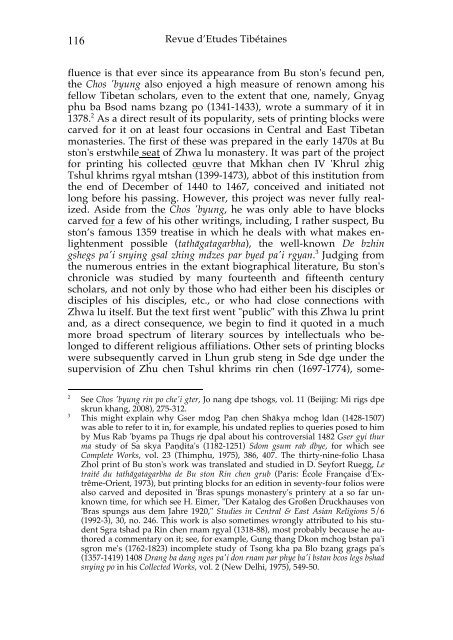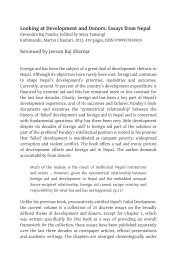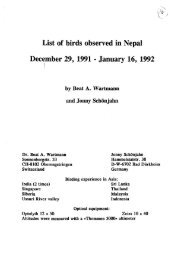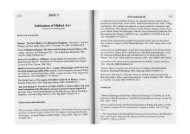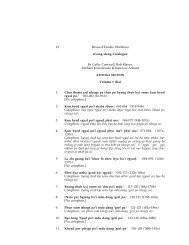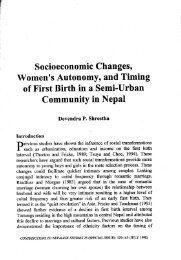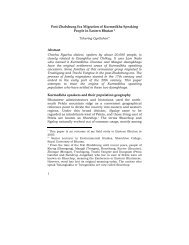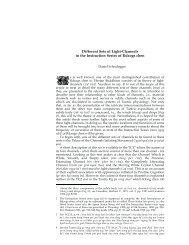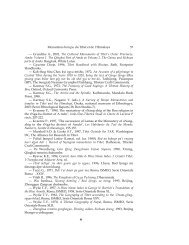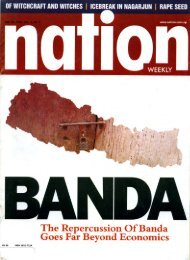Some Remarks on the Textual Transmission and Text of Bu ston
Some Remarks on the Textual Transmission and Text of Bu ston
Some Remarks on the Textual Transmission and Text of Bu ston
You also want an ePaper? Increase the reach of your titles
YUMPU automatically turns print PDFs into web optimized ePapers that Google loves.
116<br />
Revue d’Etudes Tibétaines<br />
fluence is that ever since its appearance from <strong>Bu</strong> st<strong>on</strong>'s fecund pen,<br />
<strong>the</strong> Chos 'byung also enjoyed a high measure <strong>of</strong> renown am<strong>on</strong>g his<br />
fellow Tibetan scholars, even to <strong>the</strong> extent that <strong>on</strong>e, namely, Gnyag<br />
phu ba Bsod nams bzang po (1341-1433), wrote a summary <strong>of</strong> it in<br />
1378. 2 As a direct result <strong>of</strong> its popularity, sets <strong>of</strong> printing blocks were<br />
carved for it <strong>on</strong> at least four occasi<strong>on</strong>s in Central <strong>and</strong> East Tibetan<br />
m<strong>on</strong>asteries. The first <strong>of</strong> <strong>the</strong>se was prepared in <strong>the</strong> early 1470s at <strong>Bu</strong><br />
st<strong>on</strong>'s erstwhile seat <strong>of</strong> Zhwa lu m<strong>on</strong>astery. It was part <strong>of</strong> <strong>the</strong> project<br />
for printing his collected œuvre that Mkhan chen IV 'Khrul zhig<br />
Tshul khrims rgyal mtshan (1399-1473), abbot <strong>of</strong> this instituti<strong>on</strong> from<br />
<strong>the</strong> end <strong>of</strong> December <strong>of</strong> 1440 to 1467, c<strong>on</strong>ceived <strong>and</strong> initiated not<br />
l<strong>on</strong>g before his passing. However, this project was never fully realized.<br />
Aside from <strong>the</strong> Chos 'byung, he was <strong>on</strong>ly able to have blocks<br />
carved for a few <strong>of</strong> his o<strong>the</strong>r writings, including, I ra<strong>the</strong>r suspect, <strong>Bu</strong><br />
st<strong>on</strong>’s famous 1359 treatise in which he deals with what makes enlightenment<br />
possible (tathāgatagarbha), <strong>the</strong> well-known De bzhin<br />
gshegs pa'i snying gsal zhing mdzes par byed pa'i rgyan. 3 Judging from<br />
<strong>the</strong> numerous entries in <strong>the</strong> extant biographical literature, <strong>Bu</strong> st<strong>on</strong>'s<br />
chr<strong>on</strong>icle was studied by many fourteenth <strong>and</strong> fifteenth century<br />
scholars, <strong>and</strong> not <strong>on</strong>ly by those who had ei<strong>the</strong>r been his disciples or<br />
disciples <strong>of</strong> his disciples, etc., or who had close c<strong>on</strong>necti<strong>on</strong>s with<br />
Zhwa lu itself. <strong>Bu</strong>t <strong>the</strong> text first went "public" with this Zhwa lu print<br />
<strong>and</strong>, as a direct c<strong>on</strong>sequence, we begin to find it quoted in a much<br />
more broad spectrum <strong>of</strong> literary sources by intellectuals who bel<strong>on</strong>ged<br />
to different religious affiliati<strong>on</strong>s. O<strong>the</strong>r sets <strong>of</strong> printing blocks<br />
were subsequently carved in Lhun grub steng in Sde dge under <strong>the</strong><br />
supervisi<strong>on</strong> <strong>of</strong> Zhu chen Tshul khrims rin chen (1697-1774), some-<br />
2<br />
3<br />
See Chos 'byung rin po che'i gter, Jo nang dpe tshogs, vol. 11 (Beijing: Mi rigs dpe<br />
skrun khang, 2008), 275-312.<br />
This might explain why Gser mdog Paṇ chen Shākya mchog ldan (1428-1507)<br />
was able to refer to it in, for example, his undated replies to queries posed to him<br />
by Mus Rab 'byams pa Thugs rje dpal about his c<strong>on</strong>troversial 1482 Gser gyi thur<br />
ma study <strong>of</strong> Sa skya Paṇḍita's (1182-1251) Sdom gsum rab dbye, for which see<br />
Complete Works, vol. 23 (Thimphu, 1975), 386, 407. The thirty-nine-folio Lhasa<br />
Zhol print <strong>of</strong> <strong>Bu</strong> st<strong>on</strong>'s work was translated <strong>and</strong> studied in D. Seyfort Ruegg, Le<br />
traité du tathāgatagarbha de <strong>Bu</strong> st<strong>on</strong> Rin chen grub (Paris: École Française d'Extrême-Orient,<br />
1973), but printing blocks for an editi<strong>on</strong> in seventy-four folios were<br />
also carved <strong>and</strong> deposited in 'Bras spungs m<strong>on</strong>astery's printery at a so far unknown<br />
time, for which see H. Eimer, "Der Katalog des Großen Druckhauses v<strong>on</strong><br />
'Bras spungs aus dem Jahre 1920," Studies in Central & East Asian Religi<strong>on</strong>s 5/6<br />
(1992-3), 30, no. 246. This work is also sometimes wr<strong>on</strong>gly attributed to his student<br />
Sgra tshad pa Rin chen rnam rgyal (1318-88), most probably because he authored<br />
a commentary <strong>on</strong> it; see, for example, Gung thang Dk<strong>on</strong> mchog bstan pa'i<br />
sgr<strong>on</strong> me's (1762-1823) incomplete study <strong>of</strong> Ts<strong>on</strong>g kha pa Blo bzang grags pa's<br />
(1357-1419) 1408 Drang ba dang nges pa'i d<strong>on</strong> rnam par phye ba'i bstan bcos legs bshad<br />
snying po in his Collected Works, vol. 2 (New Delhi, 1975), 549-50.


